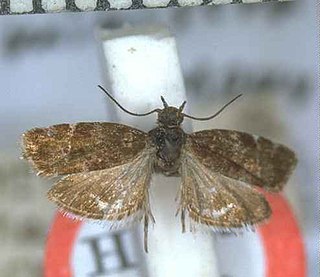
Chilades lajus, the lime blue, is a small butterfly found in India, Sri Lanka, Myanmar, Taiwan, Hong Kong, Hainan, Mangulam Island, Sulawesi and the Philippines that belongs to the lycaenids or blues family.

Callenya melaena, the metallic hedge blue, is a small butterfly found in India that belongs to the lycaenids or blues family.
Catalexis is a genus of moths in the family Gelechiidae. It contains the species Catalexis tapinota, which is found in Guatemala.

Corocosma memorabilis is a species of moth in the family Oecophoridae. It is endemic to New Zealand.

Asterivora colpota is a moth in the family Choreutidae. It was first described by Edward Meyrick in 1911. It is endemic to New Zealand and is found throughout the North and South Islands. It is regarded as a lowland species and adults are on the wing from November until March. This moth has been collected by beating shrubs.

Asterivora iochondra is a species of moth in the family Choreutidae. It is endemic to New Zealand and was first described by Edward Meyrick in 1911. This species has been observed in both the North and South Island at Mount Holdsworth and Mount Arthur. This species inhabits open spaces on mountains on the forest edge at 3000 ft altitude. Adults of this species are on the wing in February and flies rapidly in sunshine.

Asterivora ministra is a species of moth in the family Choreutidae. It is endemic to New Zealand and has been observed at Mount Holdsworth and Mount Arthur. This species inhabits alpine native herbage above the tree line. The adults are on the wing in February.

Amblyptilia epotis is a moth of the family Pterophoridae. It is endemic to New Zealand and is found in the South and Stewart Islands. It inhabits mountainous terrain covered in alpine vegetation or alternatively alpine wetland habitat. The adults of this species are on the wing from February to March. In appearance the adults of this species are variable in colour however this species can be distinguished from similar species by the oblique apical streak on its forewings as well as the patch of white on the costa cilia towards the apex of the forewing.
Rhynchoferella syncentra is a moth of the Copromorphidae family. It is found in Madagascar and South Africa, where it is known from Kwazulu-Natal, Mpumalanga and Gauteng.
Dichomeris leucostena is a moth in the family Gelechiidae. It was described by Walsingham in 1911. It is found in Mexico (Guerrero).
Dichomeris renascens is a moth in the family Gelechiidae. It was described by Walsingham in 1911. It is found in Mexico (Tabasco).
Dichomeris habrochitona is a moth in the family Gelechiidae. It was described by Walsingham in 1911. It is found in Panama.
Gnorimoschema ericameriae is a moth in the family Gelechiidae. It was described by Keifer in 1933. It is found in North America, where it has been recorded from California.
Scrobipalpa parvipulex is a moth in the family Gelechiidae. It was described by Walsingham in 1911. It is found in Algeria.
Untomia latistriga is a moth of the family Gelechiidae. It was described by Walsingham in 1911. It is found in Mexico (Morelos).
Anacampsis rhabdodes is a moth of the family Gelechiidae. It was described by Thomas de Grey in 1910. It is found in Mexico (Tabasco).
Hypercallia gnorisma is a moth in the family Depressariidae. It was described by Lord Walsingham in 1912. It is found in Mexico, Guatemala and Panama.
Antaeotricha demotica is a moth in the family Depressariidae. It was described by Lord Walsingham in 1912. It is found in Mexico (Guerrero) and Guatemala.
Antaeotricha prosora is a moth in the family Depressariidae. It was described by Lord Walsingham in 1912. It is found in Panama.

Tingena penthalea is a species of moth in the family Oecophoridae. It is endemic to New Zealand and has been observed in Wellington and the Tararua Range. The adults of this species are on the wing from December until February.







